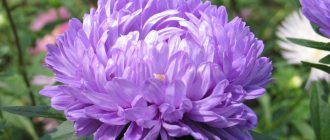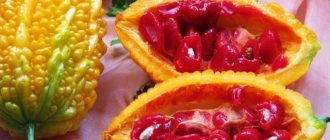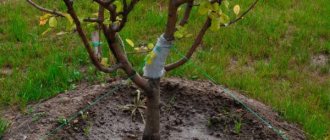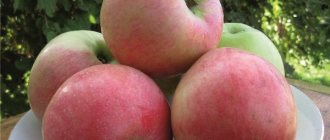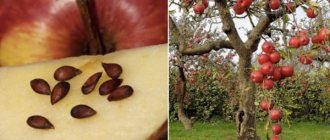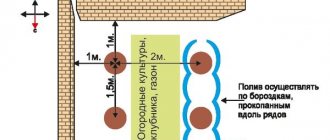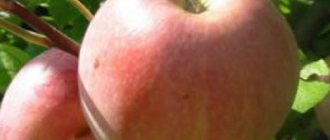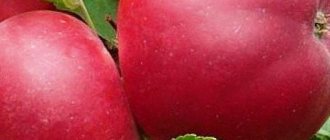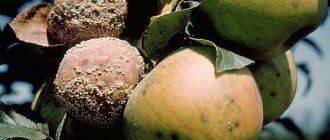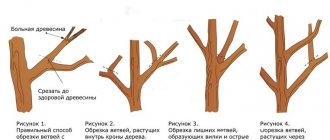Gardening » Apple tree
0
549
Article rating
Kira Stoletova
The standard apple tree is a variety loved by many gardeners. It has an even trunk, which looks like a cane driven into the soil, and on top of it there are many flowing branches or a spherical “cap” of leaves. Of course, her appearance is pleasing to the eye. This result can be achieved by grafting or pruning.
Features of growing a standard apple tree
Standard apple tree - what is it?
A trunk is a section of a tree trunk that extends from the surface of the ground to the beginning of the branches. Standard plants are plants with a pronounced, bare trunk on which is located a crown formed in the shape of a ball.
Standard forms are quite common in city parks because they form attractive compositions. However, this approach is not solely the decorator's vision. The fact is that trees with a standard crown shape are better ventilated, actively develop, bear fruit and receive a sufficient amount of sunlight. Therefore, focusing on these advantages, breeders began to purposefully develop standard fruit trees.
Standard apple tree
Standard apple trees have many advantageous features, which attract the attention of gardeners. Is it possible to successfully grow standard apple varieties on your own plot? For an experienced agronomist, as a rule, this is not difficult, but beginners will first have to familiarize themselves with the rules for forming standard forms and caring for them.
Description and cultivation of damsons Pride of Siberia
Planting and caring for a columnar apple tree
A natural mutation of the apple tree, which aroused the interest of breeders in obtaining high-yielding varieties of columnar apple trees, was noticed a little over 50 years ago in Canada. All the young trees obtained through grafting became an exact copy of the unusual branch; the apples were located on short fruit branches and even on an erect stem.
Already in the 80s, the first varieties of compact apple trees producing rich harvests were created, which immediately attracted the interest of domestic gardeners. True, due to the unusual structure of columnar apple trees, planting and caring for plants has its own characteristics.
The main difference between columnar fruit trees and conventional fruit trees is that plants grow much slower as a result of mutation, which especially concerns side shoots and the root system.
The benefits of this feature become obvious:
- when planted on a small plot of land, you can create a full-fledged apple orchard;
- when caring for columnar apple trees, since it is easier to harvest from low compact crowns, it is easier to prune and treat trees from pests.
And the number of flower buds formed on tiny side branches is amazing.
About the apple tree
Ornamental varieties of apple trees, like their cultivated relatives, bear fruit. However, their fruits are not always suitable for consumption. Caring for an apple tree and the subtleties of planting are slightly different, but they are not complicated. Apple tree
Tree morphology
A young apple tree is not tall, usually up to 3 meters. But its branches are very long and flexible, they are completely covered with leaves, so they bend to the ground under their weight. It is very important to carry out pruning in a timely manner so that the shape of the crown is neat. Apple trees, depending on how the crown is formed, can be grown in a composition or as a single decoration. Trees grafted on a trunk deserve special attention.
Weeping red apple tree.
Description of fruits
The fruits are very small, bright red in color. There are a lot of them, the branches seem to be completely covered with them on all sides. The fruits stick tightly to the shoots, even after the onset of frost, which will add decorativeness. The fruits taste sweetish, although not in the generally accepted sense. They can be eaten fresh and even made into jam. Gardeners often make cider from them.
Productivity
It is difficult to give an exact figure for how many fruits can be collected from one tree. Apples completely cover the branches, there are simply a huge number of them. Therefore, the exact weight of the collected fruits depends on the width and length of the crown branches. But there are really a lot of them.
Frost resistance
The Plakuchaya variety can be cultivated throughout almost the entire territory of the Russian Federation, with the exception of rare very cold regions. It is also widespread in nearby countries and throughout Europe. The dense bark with which the shoots are covered allows them to survive even severe frosts.
Pruning diagram for columnar apple trees
Pruning columnar apple trees is carried out not only to maintain the appearance of the crown and remove old or damaged branches; the regularity of fruiting and the quality of ripening apples largely depend on this procedure.
The role of a kind of core of the entire tree is played by a guide shoot, which sets the vertical growth of the entire apple tree. This shoot cannot be pruned, but is tied to a strong support. If the apical bud is damaged, or the main shoot annually produces an increase of less than 10–15 cm and two or three side branches, it is cut off, leaving 2–3 healthy buds for renewal. Although the growth of lateral branches in columnar apple trees is greatly slowed down, the trees are capable of forming quite powerful shoots.
If you look at the crown of such a tree, you will notice:
- the closer the position of the branch is to the vertical, the stronger its growth;
- horizontal small branches give minimal growth, and the bulk of flower buds are laid on them.
The most powerful vertically growing competing shoots are either cut into a ring, or fruiting zones are formed on their basis with the help of competent pruning. Moreover, the formation of the apple tree crown begins in early spring, already in the first year of the tree’s life.
The scheme for pruning a columnar apple tree is quite simple:
- In the spring, before the sap begins to flow, the side shoot is pruned so that only two active buds remain, which will produce strong branches over the summer.
- Next year, the one-year shoot, located closer to the horizontal, will lay flower buds and then ovaries. And the young branch that is directed upward is again cut into two buds.
- In the third spring, the branches that bore fruit last year are removed, and the rest of the procedure is repeated as before.
Fruiting zones, formed on the basis of lateral shoots, produce a harvest from 3 to 5 years, after which they are cut into a ring, due to which the trunk of a slowly growing tree is formed.
Using a video demonstrating the intricacies of pruning columnar apple trees, you can study in detail all the stages of this mandatory measure of plant care. Sometimes gardeners are faced with a situation where flower buds formed on the trunk itself, after pruning, degenerate into side shoots. In this case, it is better not to wait until lignification begins, and to include the removal of still green buds of branches in the regular care of the apple tree in summer and spring.
LOW STAMP
Using this seedling as an example, I’ll show you that at a height of 30–40 cm, we cut off our apple tree and our pear. When we cut, the bud that is located closest to the top gives a conductor and the 3 subsequent buds begin to work. They will give both twigs and buds. And we nurture these branches, making sure that they do not grow close to each other, so that there is no sharp angle. To do this, you can place spacers in a circle. We remove everything below these three branches. We leave the conductor - the upper bud, shoot replacement and 3-4 branches, skeletal branches - the main branches. They are the ones who will produce the harvest. Depending on the variety, and each variety has its own growth force, 2-3-4 tiers are formed on the crown. But the most important thing is that on the 1-2 tier, at the level of our eyes, the entire harvest is located. You must form each tier yourself. If the plant is tall, then the lateral branches can be very long. Therefore, the crown is formed according to the following law - the length of the conductor should be one and a half times greater than the length of each tier of branches. That is, it should be saucer-shaped. This is the most reliable form of crown in our harsh conditions. And it gives more yield compared to other crown forms.
How to grow a slate apple tree
The growing procedure takes place in stages. It begins with planting a young one-year-old seedling. It is planted vertically in spring
After two weeks of growth, you need to cut off the top of the seedling and carefully tilt it
After the first few branches have appeared, their growth also needs to be directed
They will grow vertically, but they need to be secured in a horizontal position, carefully using wire pins
Slate-shaped apple tree.
The procedure must be performed correctly on young branches, those that have not yet become woody. If the stiffened one is tilted and then the support is removed from it, it will return to its original place. The branches must be positioned so that they are on different sides and do not interfere with each other.
Specifics of cultivation in Siberian conditions
The climate of Siberia is so harsh and aggressive that ordinary apple trees cannot survive in it. There are local varieties that are designed to grow in these conditions. But they have a number of disadvantages - small fruits, rather mediocre taste and, most often, a short shelf life.
That is why the creeping apple tree is an essential member of the fruit plot. Thanks to their crown lowered to the ground, they are easily covered with snow, which is a real protection from the cold. At the same time, the apple tree retains the shape and taste of the variety.
Popular varieties
Modern selection offers several varieties of fruit crops, which are distinguished by their raised crown.
Such trees are a unique decoration of the garden. Mostly, these are weeping forms with different stem heights.
Calville snowy
A tree with a dense, spherical crown, cup-shaped large inflorescences and small leaves.
The apples are round, with a light green cover; after ripening in September, they acquire a yellowish color. The surface is thin and glossy. The inside of the fruit is white with a granular structure, similar to the VEM variety.
The shelf life of the fruit is about 5 months.
The plant is characterized by intensive growth and high productivity - up to 25,000 kg of fruit can be harvested from 1 hectare. Fruiting is stable, annual. Frequent and abundant watering has a beneficial effect on the quality and quantity of the crop.
It has poor frost resistance, but good resistance to scab.
Gardeners love this variety for its juiciness and rich aroma - the fruits are consumed fresh and used for making juice.
Imbelyan
A tall tree with a compact wide crown, reaching 4-4.5 m in height at maturity.
The first harvest is produced in the fourth year after planting and is practically not damaged by scab.
The fruits are beautiful in appearance, round, white-yellow, light weight - 100 g, ripen in September. Inside, the fruit is finely grained, white, juicy with a light aroma.
Yields are above average - about 60 kg per plant. In a cool and dry room, the harvest can be preserved for two months.
Gem
A fruit crop with a rounded crown differs from other varieties in several qualities:
- the fruits are large, oval, weight varies from 160 to 300 g;
- the cover is greenish-yellow with longitudinal red stripes;
- pulp with a fine-grained structure, white-green, juicy and sweet and sour in taste;
- The shelf life is long - under proper conditions until spring.
The plant has two advantages - high resistance to disease and frost resistance. Suitable for cultivation in the Middle Zone, Bashkiria. In Siberia it is grown in the stale form.
The variety gives a good harvest, subject to annual radical pruning in the spring.
Summer is red
A low-growing crop with a pyramidal crown has increased cold resistance, productivity and disease resistance. The plant is sensitive to overwatering, so it is important to follow the norm with each moistening - no more than 50 liters and no more than once a month.
The first fruiting begins in the 4-5th year of cultivation. The ovaries are formed on the shoots of the previous and current year.
Medium-sized fruits - up to 200 g, light green, with a red streaked blush. The pulp is creamy in color, with a rich aroma and a fine-grained structure. The apples taste sweet with a slight sourness.
Harvesting is carried out in the last ten days of August; the fruits are stored for about two months.
Candy
This crop grows quickly and begins to bear fruit in the fourth year of cultivation. The crown is spherical, massive, and does not deform even in a good year.
Belongs to the group of early varieties - ripens by the middle or end of August, depending on weather and climatic conditions. Fruits do not fall off for a long time.
The fruits are medium-sized, spherical - weight from 150 to 170 g. The cover is red. The inside is beige in color, the flesh is sweet, with a light caramel aroma.
Productivity is stable and high.
Minus - short shelf life, about 1.5-2 months.
Erimar
The apple tree is small in size - height 3.5-4 m. The shape is spherical with drooping branches. This crop is prone to thickening, so the crown needs to be thinned annually in early spring.
The tree has good frost resistance, but does not tolerate spring frosts well - most of the shoots freeze.
Produces small fruits - weight from 40 to 80 g. The main cover is lemon with a striped pink blush. Inside, the fruit is fine-grained, creamy, with a pronounced aroma and sweet taste.
Up to 70 kg of fruit can be removed from one mature tree. A ripe crop does not fall off the crown for a long time. Shelf life is three months.
Red early
The apple tree does not grow very tall
An apple tree of medium height (3-4 m) with a spreading crown. It has several qualities:
- early fruiting - the first fruits are given in the 2nd or 3rd year of cultivation;
- high immunity against scab and powdery mildew;
- winter hardiness indicators are high.
The harvest ripens in the second half of August. The fruits are small - up to 150 g in weight, green with a reddish blush, white inside, juicy and sweet.
Due to their excellent marketability and dense cover, apples tolerate transportation well and can be stored for up to six months.
Ruby dooks
The winter early-fruiting hybrid has two important qualities for gardeners - high productivity and resistance to severe frosts. Plus, the harvest of this crop tolerates transportation well and is stored for about 5-6 months.
The fruit weighs from 170 to 190 g with a burgundy cover, tastes sour with a slight sweetness. The pulp is dense, firm, with a slight aroma.
Ripening occurs in September-October, depending on the climate zone.
Mom's cups
A medium-sized apple tree with a thick and lush crown is one of the best achievements of folk selection. The fruits have an unusual elongated shape, reminiscent of cups. The branches are drooping, elastic, well developed.
The variety is characterized by high productivity, and if the tree is pruned on time, it practically does not get sick and is not damaged by parasites.
The fruits are burgundy, sweet, juicy with a delicate apple aroma, and ripen by the beginning of autumn. Average weight - 150-190 g.
This plant has good frost resistance and easily recovers after freezing.
Growing an apple tree on a dwarf rootstock
In general, the agricultural technology for growing low-growing trees is the same as for growing vigorous ones. It includes formative and sanitary pruning, watering, fertilizing, protecting plants from pests and diseases.
* Apple trees on a dwarf rootstock begin to bear fruit early (2-3 years after grafting). The fruits in such plantings have higher commercial qualities (apples are larger, brighter in color, better taste, but with a slightly reduced shelf life;
,
,
Globular shapes
inverse
or goat
Then the soil taken out of it is poured into the hole, adding to it in parts the same amount of fertilizer that is given for other soils. But they will not fill the hole completely, but only with a layer of 15–20 cm. The soil is leveled, compacted, and prepared compost 2–4 cm thick is again poured onto the leveled layer. Then the soil removed from the pit is added again, etc. This is done when preparing planting pits for all crops, that is, a layer of compost is created every 15–20 cm of soil. Since the depth of the planting holes is different for different plants, the number of these layers is different. For apple and pear trees they make three or four, for cherries and plums two or three, and for berry bushes two. These layers retain water and prevent nutrients from easily seeping down.
The formation of such trunks begins during the period of rapid growth of young seedlings
Maple
Thus, low-growing apple trees combine winter hardiness, early fruiting, productivity, ease of care and compact plant size.
* the yield per unit area in dwarf plantings is higher than in conventional plantings (instead of one on a vigorous rootstock, you can plant 2-3 on a dwarf rootstock);
gooseberry
almond
no less interesting. Globular
- shoots hang down in an arc; actual weeping form, or
willow
Collective and personal gardens sometimes have to be planted in damp, swampy areas or in areas with high groundwater levels. Planting trees on mounds (at least 2–3 m in diameter and 50–70 cm in height) helps to improve the growth and productivity of apple trees in such areas. Landing on a mound is done like this. First, drive a strong stake and dig up the soil around it in a circle with a diameter of 3 m to a depth of 18 - 20 cm.
Seedlings must be purchased in the fall
After acquisition, the roots of the seedlings should be wrapped in a damp rag, matting, straw, grass, or covered with damp moss or paper, and then carefully tied around the roots and above-ground system (which should be without leaves) with twine or wrapped in film. The roots should not be allowed to dry out. Miniature trunks - a trend in garden fashion
But all their beauty will only be emphasized by correctly chosen undergrowth. Its task is to hide the soil near the stem. The undergrowth looks elegant, repeating the color of the leaves or flowers of the standard plant itself. If it matches the shape of the leaves or inflorescences, the result will be amazing. This beauty will also be a magnificent decoration of the garden.
Miniature trunks are a trend in garden fashion. But all their beauty will only be emphasized by correctly chosen undergrowth. Its task is to hide the soil near the stem. The undergrowth looks elegant, repeating the color of the leaves or flowers of the standard plant itself. If it matches the shape of the leaves or inflorescences, the result will be amazing. This beauty will also be a magnificent decoration of the garden.
Pines
We form the crown gradually: every three to six weeks the shoots are shortened, because of this new branches will grow. Perfection of form is one of the main characteristics of true beauty. This statement is also true in the issue of site design. The standard form of shrubs is gaining more and more popularity: there is probably not a gardener today who would not want to see this innovation on his site.
*short trees are more convenient to care for and harvest (the fruits are less damaged during harvesting). The effectiveness of protective measures when treated with pesticides increases (the consumption of pesticides decreases, access of the working fluid to all parts of the crown improves);
, red viburnum, Buldenezh, Hungarian
greeninfo.ru
Landing
Decorative apple trees can be planted in spring or autumn. Moreover, it is not necessary to plant only the youngest seedlings; varieties up to 4 years old take root well. However, older apple trees can also be replanted, although the procedure should only be carried out in the fall, and they will take a little longer to take root.
Sapling of the Weeping Red-flowered apple tree variety.
The distance between the apple trees should be so large that there is enough space for the crown. Usually it should be about 3 meters, no more. Even if they are planted in a group for decoration, distance must be maintained. During the growing season, the tree increases significantly in size.
When planting, you will need to prepare the hole in advance, as for ordinary fruit trees. But their size should be quite large, about a meter deep and about a meter in diameter. Fertilizers should be in the form of humus and mineral supplements. When planting, you must ensure that the root collar is above ground level.
Plant species
The height of a standard tree usually does not exceed two meters. But some specimens grow up to 5 m. Properly decorated plants look attractive at any time of the year. Even in winter, when all the leaves fall, the crown retains its spherical shape. It becomes covered with snow, turning the tree into a huge snowflake. And in the summer the first flowers and fruits appear.
In addition to beauty, such plants have other advantages. Standard trees are quite compact; they will not take up much space on the site. A round crown is easier to process and harvesting from it is much simpler.
The most common form of trunk is weeping. Usually they try to stylize rowan, elm, goat willow, and some varieties of apple trees.
Such plants were transplanted to the site from the wild or bred artificially.
If you graft a tree at the bottom of the rootstock, the branches will be creeping.
And when working with a tall trunk, you will get a penetrating crown; it comes in four types:
- reflex;
- inverse;
- pendula;
- umbrella.
With a reflex, the shoots grow vertically downward, and with inversion, in an arc. A pendula is a crown shape in which the branches hang at an angle of 60 or 30 degrees. In umbrella trees, the shoots are directed horizontally and rise slightly.
If you form a trunk on shrubs such as cotoneaster or juniper, their crown will be weeping. And thuja, acacia, larch and maple will take the shape of a ball.
Such trees are usually planted along alleys or near buildings to maintain asymmetry. They look good with pyramid-shaped shrubs.
Selection and creation of apple tree crown shapes.
The selection and creation of crown forms should be linked to the density of trees on the site. Fruit trees need good lighting, which determines the quantity and quality of the harvest. Therefore, the shape of the crown affects the yield and longevity of trees. Depending on the varieties and growing conditions, each gardening zone has its own crown shapes. For standard trees, the following crowns can be used: sparsely-tiered, vertical palmette, spindle-shaped. Many gardeners allow a free-growing crown, that is, they leave it without formation. A sparsely tiered crown. The skeleton (skeleton) of a tree is formed from a conductor and three to four skeletal branches of the first order. They are placed on the conductor in tiers or individually. There can be no more than two branches in the lower tier. The distance between the tiers and single skeletal branches on the conductor is 40 - 60 cm. The crown skeleton will be strong if the branches are strong and subordinate to the conductor (that is, the ends of all branches are 20 - 25 cm below the conductor); the diameter of the skeletal branches at their base will not exceed half the diameter of the conductor at the point of their connection; the angle between these branches and the conductor (divergence angle) will be 45 - 60°; all skeletal branches are evenly located in space, that is, the angle of “divergence” between two adjacent branches can be within limits. 90 - 150°.
Read more…
Trimming branches
The easiest way to make a standard is by cutting shoots. Beginning gardeners can also cope with this technology. It is necessary to trim the side shoots, giving the tree a ball shape. But this will take many months, although the result will exceed all expectations.
It’s easy to decorate a tree with your own hands. It is enough to follow some rules:
- choose the right seedling;
- tie up a plant;
- use support;
- pin the top.
It is important to choose a suitable seedling. It should have a smooth, even trunk. Only from this can a standard tree be grown. Immediately after planting, the tree is tied to a metal peg. This will ensure proper growth. As the seedling grows, it is constantly tied to a support to keep it level. Once the tree reaches the desired height, you need to pinch its top.
After this procedure, side shoots will begin to actively grow. This usually takes no more than one year. The young plant also needs to be pinched regularly, then you can form a round crown with your own hands.
Care
Caring for an ornamental apple tree is quite simple and differs only slightly from caring for familiar garden varieties. The Weeping apple tree is immune to brown spot, but requires additional protection from scab and powdery mildew. These fungal diseases often affect all parts of the tree, so preventive spraying with fungicidal preparations must be included in the complex of care measures.
Top dressing
Nitrogen fertilizers are applied twice during the season. The first time was at the beginning of growth and development, in May. The second time fertilizing with nitrogen is added in mid-summer. These two fertilizers are important to provoke the development of powerful growths that will make up the crown.
After 3-4 years of development, it is necessary to reduce the amount of nitrogen. This is important for the plant to begin to bear fruit. For full development, mineral foliar fertilizers can be applied.
Watering
It is important to apply sufficient water under the trees. Proper watering is the key to the health of the Weeping apple tree. Usually it is enough to add moisture three times a season, in the spring, during the ripening of fruits and in the fall. The standard amount of water is 30-50 liters for each tree. But if groundwater is close, then the amount of water decreases.
Watering apple trees in summer.
Trimming
Formative pruning is carried out every year in the spring. All branches that are too long, damaged or frozen are removed. If there is excess growth, shoots can be cut off in the fall. However, it is important to be careful not to cut off fruiting shoots.
Feeding columnar apple trees and frost protection
When considering the question of how to care for an apple tree, one cannot ignore the mandatory fertilizing for this crop, careful loosening of the soil, weed control and mulching.
At least three times per season, columnar apple trees should receive foliar feeding with a urea solution with a concentration of about 0.1%:
- In the spring, organic matter is applied under the trees.
- In the first half of June, when the growing season is in full swing, the plants receive a complex fertilizer containing nitrogen, phosphorus and potassium.
- From August, nitrogen and organic matter are excluded from fertilizing, but potassium is extremely necessary for trees. This element will help the shoots to ripen, and the columnar apple trees will be well prepared for the coming winter.
To speed up the ripening of the apical parts of the shoots, in mid-August the leaf blades of the upper leaves of apple trees are shortened by two-thirds.
As a measure to care for columnar apple trees, young plants up to the age of 3–4 years must be protected from possible freezing. To do this, not only the root zone, but also the entire conductor shoot is insulated with improvised materials so that the wood does not rot and is not exposed to the risk of rodent attacks. When snow cover is established on the site, the trunks of the apple trees are sprinkled with snow.
Columnar apple tree - video
Grafting method
You can get beautiful trees by grafting. But this option requires much more effort and time. You need to purchase two seedlings - a rootstock and a scion. The first will be used as a standard, and the crown will be formed from the second.
Although both trees should be from the same crop, it is better to choose one stronger than the other. A rose can be grafted onto a rosehip, but a rough elm is suitable for a weeping elm.
But sometimes seedlings of different crops are used. This is a more difficult method, since it is not always effective.
The standard can be decorative, and the scion can be fruitful. In this case, fruits will appear on the tree a little earlier - already in the third year after planting.
During vaccination, you also need to follow some rules:
- first you need to grow a standard;
- then the tree is grafted;
- an oblique cut is made above the upper bud of the scion;
- the resulting wedge is inserted into the standard;
- after a month, new shoots are pinched.
First, they plant a tree, tie it up and wait until it grows to a certain height. Next April you need to prepare a cutting with 3-4 live buds. An oblique cut is made above the top, and a wedge is made in the lower part with two cuts. It is inserted into a sprouted standard. This is done very carefully so as not to damage the seedlings.
The junction must be rewound with polyethylene tape and treated with garden varnish. Otherwise, the standard and scion may rot.
In about a month, the cutting will take root and produce its first buds. Next, young shoots will appear from them. They need to be carefully looked after, since it is these branches that will form the crown. Shoots must be pinched periodically. After two seasons, the tree will be fully formed and beautiful. You can plant more than one standard tree at once. There is no doubt that such a solution will radically transform landscape design.
With careful care of the plants, in a few years the garden will be completely transformed.
What else needs to be considered when growing
Columnar apple trees produce a harvest 2-3 years after planting and bear fruit for up to 15 years. This will allow you to quickly gain experience and learn how to practically solve all problems that arise.
Russian and world breeding science does not stand still, and if now the main disadvantage of these varieties is their low diversity, then in a few years it will be possible to find apples for every taste and size. Although today this is quite possible. Here are just a small part of the colony varieties registered in the State Register, highly valued by the owners:
| Variety name | Origin, year | Ripening period | Average fetal weight | Fruit color | Taste | Consumption period |
| Chervonets | Moscow, 2008 | September | 180 | Light yellow with raspberry blush | Sweet with sourness | 60 |
| Coral | Rossosh, 2005 | September | 140 | Orange-red | Sweet and sour | 90 |
| Natalya | Rossosh, 2005 | September | 140 | Light yellow | Sweet and sour | 60 |
| Victoria | Rossosh, 2005 | September | 150 | Bright red | dessert | 90 |
| Arrow | Michurinsk, 2011 | September | 160 | Greenish-yellow, with blush | Sweet with sourness | 90 |
| Gothic | Michurinsk, 2015 | September | 180 | Greenish-yellow with red stripes | Sweet with sourness | 90 |
| Ray | Krasnodar, 2004 | August | 150 | Greenish-yellow with blush | Sweet and sour | 30 |
| Ostankino | Moscow, 2002 | September | 150 | light yellow with blush | sweet and sour | 60 |
| The president | Moscow, 2004 | August | 145 | White-green | Dessert | 30 |
By following simple instructions, you can create a beautiful garden that will produce good fruit and please the eye. Yes, seedlings of columnar apple trees are more expensive and require attention from the gardener, but the resulting harvest and aesthetic pleasure will more than compensate for the effort expended.
Choose a variety to your liking and enjoy a compact ornamental tree on your site.
Ripening and fruiting
Fruiting of the Weeping apple tree usually occurs in September. The fruits are quite tasty and sweet, so you can enjoy them raw, just taken from the tree, and prepare various desserts and drinks.
The fruits ripen in large quantities every year. But sometimes, if the apple trees are covered with an excess amount of fruit, there may be less of them the next year.
Many people prefer not to eat fresh apples and grow Weeping apples only as ornamental ones. Leaves and small red apples stay on branches and shoots for a long time, even after frost. Therefore, they are not torn down, leaving the tree to decorate the area when the gray winter season comes.
Weeping red apple tree in bloom.
Formation of shrubs
The trunk can be formed not only on trees, but also on shrubs. You can work with currants, irga, gooseberries and other fruit-bearing or ornamental plants. After this procedure, the crops are much easier to care for and much easier to pick berries.
You can get standard shrubs in two ways: trim the side shoots or graft other seedlings. It is better to choose the latter method. In early spring, sap begins to actively move through the branches of the bush. Select suitable cuttings for the trunk and scion (golden currant is suitable for any plant).
Everything needs to be done the same way as with trees . On the cuttings with buds, cuts are made at the bottom and top, and they are inserted with a wedge into the germinated trunk. The junction is wrapped in polyethylene, and when the first shoots appear, it must be removed. When the film is removed, the bush must be treated with special solutions (insecticides or fungicides) to prevent parasites from appearing on it.
Currants and gooseberries cannot grow without strong support. Shrubs are fragile, so they can break under the influence of strong winds. Metal or wooden rods can be used as support. Next season the first berries will appear, but they will be different from those before. The new fruits are larger and sweeter in taste.
Reviews from gardeners
Not all gardeners risk planting ornamental varieties of apple trees on their property. But those who tried to plant Weeping left reviews about it.
Nikolai: “The edge of our plot ends with a pond, so we decided to decorate it with a beautiful tree. The Weeping Apple Tree looks very elegant in spring, completely covered with bright flowers. In autumn it is decorated with small red apples like beads. I don’t have any worries, I only spray against fungus in the spring when I’m cultivating my own in the garden.”
Marina: “My husband and I bought a dacha where this apple tree grows. At first they wanted to cut it down completely, because the condition of the tree was very bad. But they regretted it, cut off the extra branches in the fall, then in the spring and fertilized it well. It was as if the apple tree had been replaced - such beauty awaited us in the spring that we were delighted.”
Konstantin: “We were at our friends’ dacha, the children picked apples from the tree and tried them. My wife got scared and thought it was suddenly not edible and what else would happen. But they turned out to be not just good, but excellent in taste. We decided to plant the Weeping variety for ourselves. Now we have a beautiful tree on the plot, the children eat the fruits, the wife makes jam, and I make cider.”
Agricultural technology: advice from experienced agronomists
It is very tempting to plant standard apple trees in the garden, but you should understand that in addition to standard care (watering, weeding, fertilizing, loosening the tree trunk, preventing/treating diseases), specific pruning will also be required.
Planting standard apple trees
- It is recommended to give preference to annual seedlings, as they adapt faster and are less susceptible to diseases, unlike old planting material.
- The root system should not be allowed to dry out; it should always be moderately elastic in the seedling.
- The most optimal spacing between standard apple trees is at least 0.3 m, the row spacing should be about 1 meter.
- The size of the planting hole should be such that the root system of the plant fits freely there.
- You must first prepare the hole, add organic and/or mineral fertilizers, and, if necessary, provide drainage. The planting material is placed in the hole and the root system is straightened. You will need to leave some space above ground for grafting.
- After planting, it is necessary to carefully compact the soil, form a circle near the trunk and water the tree abundantly.
Wild shoots rushing upward can shoot out along the entire length of the column, from under the soil or below the graft, on the rootstock. All branches formed at the grafting site should be removed as quickly as possible. Such shoots require a lot of nutrients coming from the root system, which will have a detrimental effect on the formation and ripening of the fruit.
The shoots are actively formed only in the first three years of the tree’s life, but it is still necessary to monitor the cleanliness of the trunk.
To create an attractive appearance of the crown, you will need to cut out all shoots that change the characteristic shape. Usually, in good light, the number of uncharacteristic shoots does not exceed 5-10% of the total mass of shoots.
Standard apple trees are unique varieties that provide an alternative to vigorous trees. First of all, this species is valued due to its compactness and abundant fruiting. The latter is due to the fact that the root system supplies the tree with a sufficient amount of nutrients for the formation and development of fruits; there are few shoots - not many resources are required for their development.
Advantages
Standard culture has the following advantages when grown:
- due to its unusual and neat appearance, it can be used in landscape design;
- such a tree develops more actively, receiving more sunlight and better ventilation;
- Apple trees can also be cultivated in small areas of the garden.
Trunk plants are one of the most spectacular forms of garden plantings. They naturally attract attention and perform a decorative function. An apple tree on a trunk, unlike traditional fruit trees, becomes a real decoration of the garden. It amazes guests and casual spectators with its appearance, and pleases the garden owner with its ease of care. Standard varieties of apple trees are not yet very common in Russia, so they look unusual in domestic gardens. But experienced gardeners have known about this variety of apple trees for a long time.
Important Tips
It is difficult for novice gardeners to understand the stamping procedure, which means they can make serious mistakes. They will benefit from recommendations from more experienced owners:
- it is necessary to germinate the trunk;
- scion cuttings are selected in April;
- it is necessary to make the cuts correctly;
- It is advisable to use garden varnish.
After planting, the trunk is tied up and germinated immediately to the desired height. If this is a tree, then it should be one and a half meters or taller; for shrubs, 50-70 cm is enough. All this time it is attached to a support. In April, young cuttings are selected for scion. They must have buds on them. For a wedge, two cuts are made at the bottom, and for proper germination, one at the top of the shoot.
You need to insert the cutting into the stem so as not to damage both plants. You should not use sharp or metal objects; it is better to do everything with your hands. The attachment point is sealed with polyethylene and lubricated with garden varnish to avoid the penetration of pests and rotting.
If an ornamental plant was chosen for the trunk , then it is better to place it on the lawn. When the flowers appear, they will look beautiful against the green grass. But the space around the trunk is cleared of lawn and mulched. To do this, prepare a mixture of peat, sand, pebbles and sawdust. It is sprinkled on the ground and covered with paper or film.
The thickness of the embankment should reach 12 cm. This layer helps the soil warm up faster in summer and protects it from freezing in winter.
Mulch retains moisture, allowing the plant to constantly feed, and it also prevents weeds from growing.
Prevention of diseases and pests
Despite the high resistance to disease, gardeners carry out two preventive treatments with fungicides (Bordeaux mixture or copper sulfate).
They prevent the emergence and spread of infections:
- at the beginning of spring (late March or early April);
- in the fall (when the tree sheds its leaves).
For pests - aphids, spider mites, codling moths, leaf rollers, insecticides are used (Aktellik, Aktaru, Fundazol or Decis).
For prevention, three irrigations of the crown are required - in early April, a couple of weeks before flowering and after the ovaries appear.
Growing in regions
The fairly decent winter hardiness of the ornamental apple tree of the Plakuchee variety allows it to be grown even in regions with low temperatures in winter. But the most comfortable regions will be:
- Central;
- Volga region;
- Moscow region;
- Ukraine;
- Belarus;
- Europe.
However, weeping is periodically planted in the Urals and in the southern part of Siberia. It will only be important to insulate the apple tree, especially a young one, and to mulch the tree trunk well.
Possible difficulties
Standard tomatoes are considered the most problem-free. Difficulties may be associated with ignorance or non-compliance with agricultural technology and varietal characteristics.
Common problems and errors:
- Low quality of seeds, mis-grading.
- Sowing seedlings too early.
- Growing seedlings in heavy soil mixtures, in nurseries without drainage holes.
- Late pick.
- Sparse or dense planting in the garden bed.
- Excessive watering, excessive fertilizing.
- No garter for medium-sized varieties with full-bodied tassels.
- Unpreparedness for rapid processing (sale) of fruits with a friendly return of the harvest.
